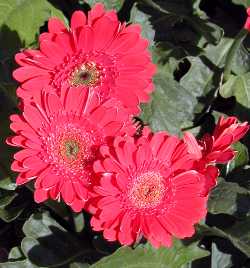
 |
The Gerbera Daisy
By Kalene Duppong
Scientific Information
Family Genus Species |
Asteraceae Gerbera jamesonii |
Height Growth Requirments Hardiness |
6-12 inches or 12-18 depending on variety Full Sun Zones 9-10 |
General Information
The Gerbera genus contains about 40 species that are generally considered the same. The most common names for this flower can be the African, Barberton, Gerbera or Transvaal Daisy. It is often mistakenly called the Gerber Daisy. The ancestors of the Gerbera diasy are native to Africa, Madagascar, tropical Asia and South America. The Gerbera daisy cultivars we know today were first bred at the end of the 19th century in England by Richard Lynch.
This flower comes in a variety of colors such as pink, red, orange, yellow, white, purple, and color variations on a single flower. The flower head can grow to almost 6 inches in diameter, which makes it a common large flower in arrangements. As a cut flower it has a relatively thick and long stem with no leaves attached. Another property that has made these flowers popular in floral shops is their long vase life. A Gerbera Daisy can live up to 14 days in a vase with the recutting of the stem and changing the water.
 |
Gerbera daisys are perennial herbaceous flowers that can be easily grown indoors with full sun/partial shade, and good drainage conditions. In the outdoors, it thrives at medium temperatures around 75 degrees F, but cannot withstand temperatures lower than 50 degrees F. Gerberas like a slightly acidic to neural soil (6.1-7.5 pH). While in bloom, the plant should have a constantly damp soil, and a healthy plant should bloom repeatedly thoughout the year. Like many plants, these daisys are susceptible to pests and disease such as aphids, mites, bacteria and certain fungi. These problems can be partially prevented by not overwatering and removing leaves close to the soil. The plants can be propagated by cuttings, seeds or division, with clumps being divided in spring. Seeds should be started indoors during the winter.
 |
 |
References and Sources
Gerbera Daisy Growing Instructions
 |
Natal National Botanical Garden
Pictures were accessed through Google Image pages.
Contact Information
Contact Kalene Duppong